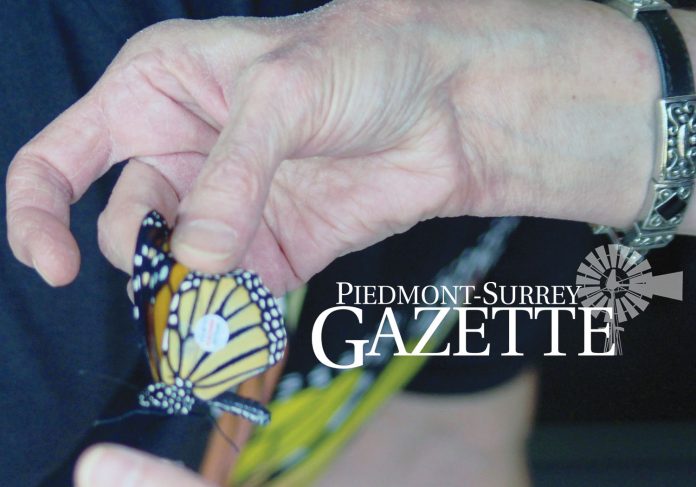By Carol Mowdy Bond
Contributing Writer
Are your eyes peeled for the monarch butterflies as they fly through your area? They’re coming through Canadian County and our newspaper staff got involved in the process.
On Thursday, September 17, Canadian County Master Gardener Janet Horner arrived at our newspaper, The Yukon Progress, Okarche Warrior and Piedmont-Surrey Gazette offices in Yukon. She enabled two of our staff, Jeremy Pyle who is head of circulation and a writer/photographer, and writer/photographer Carol Mowdy Bond, to participate in tagging and releasing monarch butterflies for their journey south to winter in Mexico.
Horner brought a clear mesh monarch tower. Hatched monarchs were flitting around inside. And monarch chrysalises were hanging from the interior roof. Horner helped Jeremy and Carol tag monarchs, with her personal tags, before releasing them.
As well, Horner brought monarch caterpillars or larvae. They hang upside down and spin a silk mat called a chrysalis. Each butterfly remains entombed in its chrysalis until ready to hatch.

Some of Horner’s caterpillars were already safe and cozy, hanging upside down, from the top of the mesh tower in their chrysalis bedrolls. Each chrysalis has gold on the exterior that you may see. The gold areas are ports of entry for oxygen into the chrysalis.
This is the peak time of year when eastern monarchs are making their trip south to Mexico, where they will winter. Their path is 500 miles wide, and Canadian County residents should be able to see them in the next week and into early October. They travel in a group so large that they show up on radar. But you may already be seeing one or two of the butterflies in your area.
Next March they will travel north from Mexico. As they travel north, they will lay their eggs. But they only lay eggs on milk weed plants. So, be sure to have your milk weed plants ready next spring.
The eastern monarch population has seriously depleted. In order to help change the situation, we need to make sure we have the correct plants ready for them during their fall migration south, so they can eat and fatten up for the journey. Then, we need to have plenty of milk weed plants, so they may lay their eggs next March as they come back north.
Besides overseeing the 5,000 square feet pollinator gardens at the BlueSTEM Agri Learning Center located at Fort Reno near El Reno, Horner also raises monarchs from eggs. Then she hatches them, tags them, and releases them. She’s a major advocate for saving our declining monarch population, and she gives presentations and demonstrations to groups.
Connect with Horner at jchorner12@yahoo.com.
You can keep up to speed on these endangered butterflies and how to help them survive, and learn when they’ll fly through your area. Go online to www.okiesformonarchs.org and www.monarchwatch.org.






